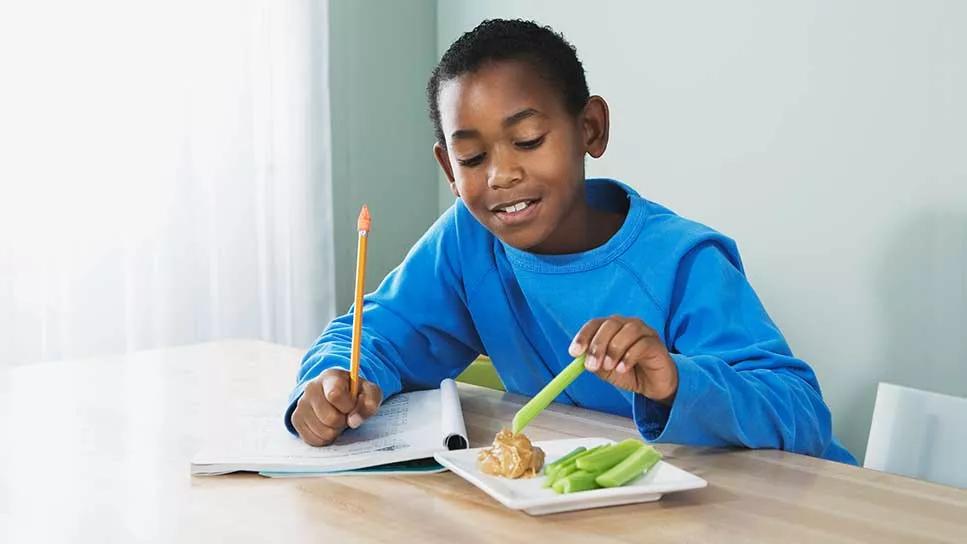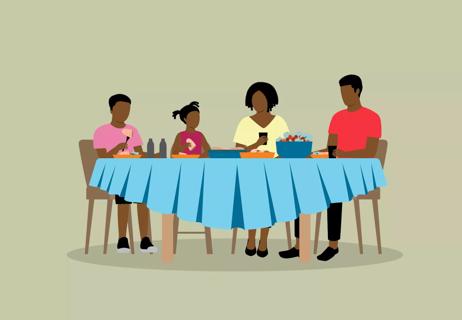Look for snacks that are low in sugar and high in fiber, protein and healthy fats

If you have kids, you know they can be hungry little beasts. Lunch is barely cleared off the table before they start rummaging through the pantry for a snack.
Advertisement
Cleveland Clinic is a non-profit academic medical center. Advertising on our site helps support our mission. We do not endorse non-Cleveland Clinic products or services. Policy
Rest assured, it’s normal and healthy for kids to need a snack between meals. That’s because kids’ bodies need significant fuel to keep up with their growth and development.
“Kids have a lot higher calorie demand per kilogram of body weight as compared with adults,” explains pediatric dietitian Hanna Leikin, MS, RD, CSP, LD. “They need those calories to support their bone development, muscle growth and bodily functions.”
Consider this. Adults need about 25 to 30 calories per kilogram of body weight. Kids need about twice as many — about 60 to 80 calories per kilogram of body weight.
And where those calories come from matters. A lot.
When your kid is looking for an after-school snack (or an after-nap snack or an anytime snack), your best bets are foods that will fill their tummies with nutrients that will keep their bodies satisfied.
Like what?
We asked Leikin for her top healthy snack ideas for kids.
Healthy snacks for kids are foods that will fill their bellies with the vitamins, minerals and nutrients they need. Specifically, healthy snacks should be:
“Healthy snacks are nutrient-dense foods,” Leikin emphasizes. “They’re the foods that are going to keep your kids’ tummies full and satisfied.”
Advertisement
In other words, healthy snacks tend to be real, whole foods. Not pre-packaged cakes, cookies, pretzels and fruit snacks. Because while those foods may be convenient, they tend to be less nutrient-dense. That means more simple carbs and sugar and less fiber and protein that will actually fill a hungry belly.
“We can eat a lot of snacks that aren’t nutrient-dense, like chips and veggie straws,” Leikin explains. “It takes more food and more time for those kinds of food to build feelings of fullness. So, we eat more of them before we feel satisfied. And by then, it's dinnertime and the kid isn’t hungry for their meal because they filled up on empty calories.”
Foods that are high in fiber and protein, on the other hand, fill you up faster, so you don’t eat as much of them. Leikin calls that the “natural instinct of portion control,” and it’s key to kids’ healthy snacking.
Need some inspiration for what to feed a kid with a case of the snackies? Leikin shares these healthy and kid-friendly snack ideas.
Leikin calls hummus a “forgotten food.” It’s not always top of mind for parents, but it’s a great source of fiber, protein and unsaturated (healthy) fats that can entice your kids to eat more veggies.
Dunking and spreading the hummus gives your child more control and interaction with their foods, which can up the fun factor compared to plain ol’ vegetables.
Looking for other ways to encourage kids to eat their vegetables? Try these strategies and kid-friendly veggies to encourage picky eaters.
If your kid likes a snack with a crunch, whole-wheat crackers can be a healthier alternative to chips and pretzels.
Pair them with healthy protein by spreading them with hummus or cottage cheese or adding a cheese slice on top.
Like avocados, olive oil and seeds, nuts and nut butters are a good source of unsaturated fat.
“Unsaturated fats are good for kids’ brain growth, hormones and overall growth and development,” Leikin shares.
Recommendations from the National Institute of Allergy and Infectious Diseases say peanut butter can be given to kids as young as 4 months old. Early exposure may even prevent peanut allergies. Remember, though, that whole nuts can be a choking hazard for little ones, so stick to nut butter until your kid is about 5 years old or older.
Leikin suggests pairing nuts and nut butters with fruits for an appealing sweet-savory combo. Try:
Advertisement
Getting kids involved in food preparation can take some of the “mystery” out of foods, which can help make them more likely to try something new.
Leikin suggests getting your kiddo involved in creating their own trail mix as a fun activity and a healthy snack.
“Pre-packaged trail mixes tend to add a lot of sugar,” Leikin notes. “When you make your own, you’re in control of what goes into it.”
Make a big batch ahead of time and portion it into zippered pouches or small containers to make a convenient on-the-go snack.
Looking for some trail mix inspiration? Try this recipe for almond and coconut trail mix or this sweet and savory heart-healthy snack mix.
Pro tip: Leikin stresses caution when adding dried fruits to your trail mix. Many of them may contain a lot of added sugar. Check the nutrition label and look for ones that contain no added sugar or artificial sweeteners.
Dairy products can be a good source of protein, calcium and vitamin D, which helps support healthy bone growth. And pairing dairy with fruit helps kids get more vitamins and that all-important fiber.
“Kids need about three to four servings of dairy per day to support their growing bones, so anytime you can help them get some more calcium and vitamin D in their diet is a good thing,” Leikin says.
Advertisement
Try this fruit and yogurt parfait recipe for a yummy, healthy and kid-friendly snack. Or keep items separate with a cup of plain yogurt and a handful of berries.
You can get similar benefits from other combinations of fruits and dairy, too. Try a glass of milk with sliced apples, cottage cheese with fruit or pears with cheese slices.
Turkey is a lean protein source and a staple in many kids’ school lunchboxes.
A slice of turkey paired with some cheese and veggies can be a hearty snack or small meal that can really pack a nutritional punch.
“I advise families to roll a slice of turkey around a cheese stick for a portable snack that’s high in protein,” Leikin suggests. “Kids tend to like it because it’s fun to have a whole snack they can hold in their hand.” Sliced chicken breast is a good choice for this healthy snack, too.
Toss some veggies on the side, like carrot sticks, celery sticks or red bell pepper slices to up the ante on fiber and vitamins.
Right, you’re probably thinking, but those pre-packaged bags of snacks are so convenient. Can’t I just make those work?
We get it. Life is busy, especially when you have kids. Packaged snacks are convenient, especially if you’re traveling, heading to yet another after-school commitment or just need a quick bite while running errands.
Advertisement
When you need to throw your kid a quick-and-easy packaged snack, there are ways to make healthier, nutrient-dense choices. Leikin says getting familiar with nutrition labels is key to making healthy snack choices for kids.
Look for packaged snacks that contain:
One of the best ways to help your child choose healthy foods and snacks is by making them just as convenient as the less healthy options.
Leikin suggests keeping family-favorite fruits and vegetables in the house, prepped and ready to be eaten. That may mean some pre-work on your part to have them washed, peeled and sliced. But it also means that they’re an easy choice to grab and munch on when snack time comes. Try to organize your fridge so the healthiest choices are front and center, in plain eyesight.
And having healthy choices on hand makes it easier for you to get the nutrition you need, too. Healthy snacks are just as important for you to keep up your energy and take care of yourself and your children.
Remember that your kids are watching your every move. And when they see you reaching for whole wheat crackers and hummus when you’re feeling peckish, they’ll learn that those are good choices for them, too.
“As parents, we’re always looking to make sure we’re doing right by our children,” Leikin encourages. “Providing nutritious snacks and role-modeling healthy behavior is just one more way to take care of yourself and your little ones.”
Learn more about our editorial process.
Advertisement

Most kids get enough protein in a regular diet — too much can have side effects

Kids typically get all the nutrients they need from food, but supplements can add peace of mind

The five major food groups offer different types of nutrients in the right proportions

Be a good role model, set family meal times and involve your kids in meal planning

How to keep kids' diets healthy while the sun heats things up

Fiber can lower blood pressure and promote healthy bowel function

Many active children don’t consume the recommended amounts

Start having sex about 72 hours before ovulation, then at least every other day during your fertile window

Attachment theory suggests that your earliest relationships shape connections throughout your life

It isn’t a recognized mental health disorder, but research shows that problematic social media use can negatively affect your mental health, self-esteem and sleep